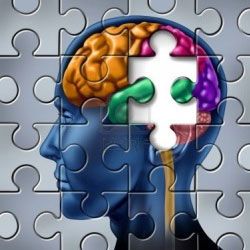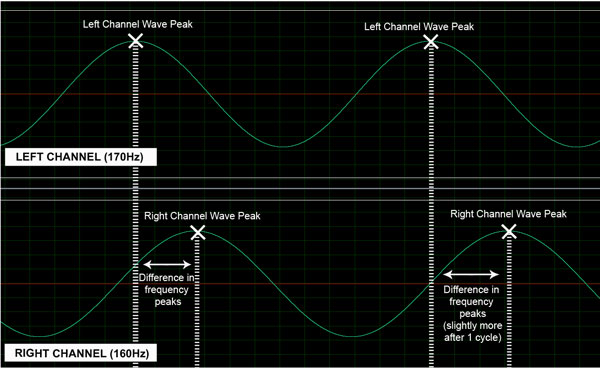What is Brainwave Entrainment & How Do I Use It On My Recordings?

Brainwave entrainment is sort of an intimidating word come to think of it. I wish they would have called the phenomena something a bit more subtle like Relaxation Frequency Technique or Calm Mind Technique. Anyways I want to outline here what brainwave entrainment is, how it works, and the methods I use for this on my own hypnosis recordings.
What is Brainwave Entrainment?
Brainwaves: are the electrical impulses in our mind that create thought & feeling
Entrainment: means to synchronize or entrain something to be like that of something else
Therefore....
Brainwave Entrainment = Synchronizing brainwaves to the same level as an external source
This is basically a process of artificially manipulating brainwave patterns to bring about changes in consciousness or state of mind. Brainwave entrainment is done through a few different methods which I will speak about soon, but the common denominator is that the brain mimics the external stimulus to influence the predominant brainwave frequencies - more about this covered my article on States of Mind here.
So why do we want to entrain our brainwaves?
Our predominant brainwave cycle (speed Hz) determines our general state of mind, consciousness and thought - everything we do basically. By changing our brainwaves we change our current condition and this can be hugely advantageous to bring all types of positive change.
- By lowering our brainwave cycle speed we enter into states of relaxation, meditation, hypnosis etc.
- By increasing our brainwave cycle speed we enter into heightened states of mind which can be good for increasing energy, physical activity, and responsiveness.
Therefore brainwave entrainment is a nice quick and easy way to bring about quite fast change to our current level of mind to suit what we need to be doing.
I use brainwave entrainment frequencies in my hypnosis recordings because my goal is for you (the listener) to reach a nice relaxed state of hypnotic trance. The frequencies I use compliment my spoken techniques to help bring your mind into the desired level of trance to bring positive change.
How Does it Work?
There are a few different methods of entrainment, but for the most part (and what I want to focus on here) these are all done via sound. In all of the techniques listed below the brain actually locks into and follows what is happening in the sound. The audible effects are done at a rate that the brain quite literally mimics to accordingly slow down or speed up brainwave patterns. It is a rough analogy but it really is kind of like 'Monkey see, monkey do' here. So brainwave entrainment is all about creating a consistent repeating sound of sorts that our mind actually becomes immersed in and soon follows suit.
It is also interesting to note that very rarely do brainwave entrainment frequencies occur naturally - as in NOT man made. This is due to natural patterns of sound not really being generated in the same continuity and frequency as of those sounds produced by man and computer like motors, electrical appliances, and musical rhythm. Repetition over a period of time is required to produce the brainwave entrainment effect although some people pick up on the effect quicker or later than others. Depending on the person it can take anywhere from 10 seconds to more than 20 minutes for a reasonable effect to be noticed by an individual using these methods.
Methods of Entrainment
Binaural Beats
These are what i use on most of my hypnosis recordings. Binaural beats are an audible effect processed from within the mind by producing two slightly different tones in both ears (assuming you are using headphones) or sides of the stereo spectrum. The 'beat' is actually an effect of how the brain processes the two different sounds internally, producing a pulsating like rhythm. It is the speed of this perceived rhythm (measured in Hertz - times per second) that actually entrains brainwaves to the same frequency. So a 10Hz (Alpha) binaural beat will entrain the brain into predominant patterns of Alpha brainwaves at 10Hz also. It is indeed an interesting effect and very very effective to reach the lower levels of trance quickly. Because binaural beats are produced within the brain (the beat is only perceived as an audible sound once the brain process the two sounds together) headphones are best used to get the desired effects because it disperses the two sounds in both speakers between both ears more evenly helping create a stronger internal effect.
Main advantages: a very strong entrainment effect is produced, very low Delta levels can be reached unlike other methods, easy to combine other sounds into the mix, can be easily embedded through modulation
Main disadvantages: Headphones work best (although there is still a monaural element which can be created through use of speakers - see below)
Isochronic Tones
Unlike binaurals, isochronic tones are processed outside of the mind - that being purely through the signals sent from the ear to the brain. They are simply a sound that constantly switches on and off creating a constant pulsating or rhythmic like effect. Each intermittent sound is separate from the next (like a drummer hitting a drum over and over at the same rate). Again predominant brainwave frequency adjusts to the same pattern or frequency produced by isochronic tones in a mimicking like effect.
Main Advantages: Can be listened on either headphones or speakers, creates a very distinct beat that is easy to process, the brain does not have to do as much as work to get the effect
Disadvantages: Low levels of Delta trance can not be achieved (the brain fails to latch on to larger gaps between beats for entrainment under 2-3 Hz), can be a little annoying and obtrusive at times (my opinion)
Monaural Beats
Monaural beats share more similarities with binaural beats, however the effect is processed outside of the brain rather than within. Monaural beats do not require use of headphones and can actually be produced from a single speaker (do not need seperate right and left channels like binaurals). They are produced by two creating seperate frequencies in the one speaker. It is the way both frequencies intertwine acoustically together that prouces the monaural effect. Again this sounds similar to the way binaural beat is made but is not. The effect comes from one speaker and is actually processed in a different part of the brain. It is the acoustic properties of the two sounds that creates the physical intepretation of a beat in the way the two frequencies interact together from a single.
Main advantages: Can be used without headphones
Main disadvantages: Harder to mix in other sounds
Modulation
It is possible to embed a beat-like effect into other sounds. Commonly used are sounds like white noise, pink noise, relaxing music, nature sounds etc. In this way the audio is manipulated so that a beat effect is produced by doing things like constantly raising and lowering volume, manipulating pitch, producing harmonic resonating frequencies etc. This way is a little more complex but can produce some very good effects when done properly and with the right choice of sounds.
For those of you who like to get technical... How Binaural Beats are Made
Carrier tones: The separate tones used each in the right and left audio channels
Pitch: The frequency of the carrier tone/s
Soundwave: The type of soundwave used to create the carrier tone - sine wave, square wave, sawtooth wave etc. (I like sine waves as they are a nice smooth linear sound)
Binaural frequency: How many times per second the brain hears the 'beat' effect it produces (measured in Hz)
The process: Create one carrier tone panned completely to the left audio channel. Create another carrier tone of a slightly different pitch panned completely to the right channel. The difference in 'Frequency' (pitch) of the two tones will be the resulting binaural beat frequency.
So an example of this would be
Right channel: 200Hz sine wave tone
Left Channel: 210Hz sine wave tone
Binaural beat = 10Hz (difference between left and right tone frequency)

Experimenting With Different Sounds
There are limitless combinations you can create for binaural beats. The variables that create different effects include the pitch of the carrier tone (I like lower pitches 150Hz - 300Hz), the rate of the binaural beat, the soundwaves used for carrier tones, other carriers (white noise, music etc.) where the binaural beat is actually embedded in the sound itself - this is known as 'modulation'. Additionally you can also 'ramp' one of the carrier tones (I like to do this on my recordings) so that the binaural beat changes progressively throughout the whole recording. This allows the listener to progressively change their state of trance and experience different levels of consciousness which is very good for hypnosis. To do this here is an example:
Right Channel: 200Hz sine wave tone
Left Channel starting tone: 210Hz
Left Channel ending tone: 205Hz
In the above example at the start there would be a 10Hz binaural beat progressing over time to a 5Hz binaural beat right at the end. Right in the middle point of the recording the beat would be 207.5Hz.
Other things you can do to experiment include adding in additional sounds like music to enhance the listening experience, layering multiple carrier tones on top of each other at the same (or even different) rates to produce harmonic effects, and even changing the speed of the binaural beat to go up and then down and up again etc. to create a journey like effect. The possibilities are infinite and really it all depends on what the listener perceives to sound best for them.
Conclusion
So there you have it. I hope this is not too much information, but hopefully now the word Brainwave Entrainment is not so intimidating as it sounds. In fact the phenomena is very interesting and very effective. I like to experiment with different combinations on my self as well as some of my friends & clients. If you ever want to be part of this process please contact me here and we can arrange to have some samples sent to you to download and use in return for your feedback.
- Giovanni





















Comments
Binaural Beats
By TomChavez on 20 Jun 2017 at about 13:25.I am thankful to you for sharing this awesome article with this helpful knowledge.
Add new comment